#Trude Berliner
Explore tagged Tumblr posts
Text

Two models by Christian Dior, Paris, F/ S 1961, illustration by Trude Rein - 1961 - Kunstbibliothek Berlin, Germany - CC BY-NC-SA.
(source: Kunstbibliothek Staatliche Museen zu Berlin via Europeana Collections)
5 notes
·
View notes
Text

Ein wunderbarer Roman, handelt von der Zeit nach dem Zweiten Weltkrieg.
Eine norwegische junge Frau namens "Tekla" verliebte sich in einen deutschen Soldaten in Norwegen und beschloss, nach dem Ende der Nazi-Herrschaft mit ihm zu fliehen.
Ihre Familie war strikt gegen diese Idee, insbesondere ihr Bruder, der beinahe von deutschen Soldaten getötet worden wäre.
Doch ihre Liebe war stärker, und sie entschied sich, mit dem deutschen Soldaten nach Deutschland zurückzukehren, was sie ihre norwegische Staatsbürgerschaft kostete.
Ihre Reise war beschwerlich, und sie wurde von ihrer Familie und der gesamten norwegischen Gesellschaft in ihrer Stadt, die sie als Verräterin bezeichnete, verstoßen.
Die Autorin beschreibt das Unglück, das in der Stadt Demmin im Osten Deutschlands stattfand, wo viele Frauen sich im Fluss das Leben nahmen, nachdem die Rote Armee die Stadt eingenommen und die Frauen und Kinder misshandelt hatte.
Tekla leidet unter dem Verlust ihres deutschen Ehemanns, der von russischen Soldaten getötet wurde, und unter den eigenen Misshandlungen, die sie durch dieselben erfuhr.
Daraufhin beschließt sie, nach Norwegen zurückzukehren, flieht jedoch nach Berlin, wo sie als Obdachlose ein entbehrungsreiches Leben führt und bis zu ihrem letzten Tag den Preis für ihre Entscheidung bezahlt.
Eine beeindruckende Geschichte, die das Leben der Menschen nach dem Zweiten Weltkrieg und das Leid der Frauen, die Misshandlungen erlebten und unter dem gesellschaftlichen Druck litten, beleuchtet.
Viele Geschichten, die von Frauen verschwiegen wurden, hat die Autorin und Journalistin Trude Teige niedergeschrieben.
0 notes
Text


She was born Katharina Stern into a creative family in Berlin. Her three sisters were actresses, and her aunt was the German artist Käthe Kollwitz. Sterna adopted her stage name, and became a dancer upon first seeing Anna Pavlova. She trained under Viennese dancer/teacher Grete Wiesenthal, and was promoted by theatrical producer Max Reinhardt.
Sterna was also in a number of German silent films during the 1910’s/1920’s, incl: “Marionetten" (1915), followed by the short film serial "Ticky-Tacky" in 1918/19. Other films: “Ein genialer Einfall" (1919), "Das Verlobungsfernrohr" (1919), "Flimmerherzen" (1920), "O du Quetschfalte meines Herzens" (1920), "Kameraden" (1921); and "Tingel Tangel" (1930), her only sound film.
Katta Sterna died in Berlin at age 85 in 1984.
(Photo by Trude Fleischmann, 1925
1 note
·
View note
Text

Trude Geiringer and Dora Horovitz - Lily Damita (b. Liliane Marie-Madeleine Carré). Ross-Verlag postcard, Berlin, nº 1935
0 notes
Text
Road to Berlin’s Episode 12 Is a Spectacular Finish to a Spectacular Show

It was damn good!
After the slightly tame setup Episode 11 provided, it fell to Episode 12 to deliver the payoff not just to the finale that Episode 10 started, but also to wrap up the overarching story of the entire season. And oh boy, did it do just that!
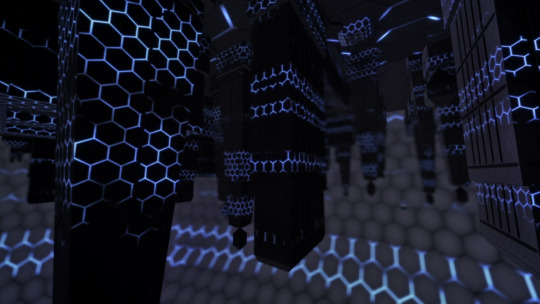
First, let’s talk about our favorite looming antagonists with barely any world-building, the Neuroi! Well, they once again upped the creepy factor by replicating World Capital Germania. How they managed to do this is still unclear, as the city never left the planning stage; it truly does seem like the Neuroi don’t just consume for sustenance or whatever, but also that they can replicate whatever they find in the territory they conquer. Of course, none of this matters much to the story at hand, but it does give us a tiny bit of world-building on them, and it would also explain some of the more bizarre Neuroi designs. Do you remember the Cube Neuroi? I do.
I was also intrigued by this former emperor of Karlsland who designed the plans for Germania. Whoever they were, they were forced to step down, but this raises all kinds of questions. When did this happen? How long has Emperor Frederick IV been in power? What does the mere existence of these plans imply about Karlsland’s history?

By the by, the building that was never in the plans seems to resemble the Great Hall, which was, in fact, shelved due to the start of WW2. Strike Witches occasionally gets some stuff hilariously wrong, but much of the research definitely seems on the money.
See, as far as I know, Nazism doesn’t exist in Karlsland. (Actually, that’d be pretty awkward for Karlsland, with the 501st’s logo being the way it is...) Judea was wiped out by Neuroi in the year 29; this, and several other differences in the world’s history, produced a different world than the one we know. (See the Strike Witches Historical Timeline for more information.) Culturally, Karlsland is far more akin to Imperial Germany, but transplanted into the 1940s and borrowing some iconography and designs.
There WAS tension in Europe before the Neuroi showed up and forced everyone to unite against a common enemy; would that have been enough incentive to create these plans, as well as structures like the Flak Tower? I hope we��ll find out someday. Either way, the fact the Neuroi created such an intricate city-shaped structure based on nothing but plans on paper is pretty terrifying. What else did the overrun countries have lying around when they were invaded?
Right, well, enough about the ancillary stuff. Let’s talk characters!

And cutting right to the chase: Shizuka definitively earned her spot on the team this episode. Yes, I know she technically earned it in the Movie at the earliest, and I guess Episode 10 at the latest. But Episode 10 still left me a bit wanting, as it was part of the process of building up to Shizuka’s turning point as a character. But now we reached that moment at long last, and it was everything I’d hoped to see.
First, RtB shows us how far she’s come. Her determination is nothing short of epic; she’s grown so much since her first engagement in the Movie, and nowhere is that more obvious than here. She lands a difficult shot on the bomb while flying a Striker her magic can’t handle, to the point where it’s physically hurting her to breathe. And then, she sees Yoshika trapped down below, and she finally passes the point of no return.

For the entire season, Shizuka’s been utterly obedient when it came to orders. As soon as someone dropped that o-word, she’d stop whatever action she was entertaining and went along with what she was told, even if it didn’t sit entirely well with her at times. She still does that at first, actually. But then, she finally sees something she can’t walk away from, and she decides to risk her own life to protect the girl who always throws herself into danger for others.
She saves Yoshika’s life, and even though she’s definitely not sounding well, she then takes up the fight in her friend’s defense without a single ounce of hesitation. Her switch from defense to offense is almost explosive; no talking, no checking on Yoshika, just straight-up switching on a dime. And her valiant stand is successful!

Until this happens, and once again I have to commend everyone involved in RtB on the gravity of this scene. Shizuka’s injury is devastating. The cinematography is chilling and incredibly well done: the way the beam punches through the profile shot of her body; how the beam takes all the colors with it as it leaves the screen, monochrome swiftly washing over the scene in its wake, Shizuka already pale; the trails of blood; the dilated eyes. They don’t show her crash, but it sounds awful. And then there’s the blood, positively pouring out of the hole in her body, spilling out until it even reaches Yoshika’s knees, a symbol for Yoshika failing to save her.
As the scene dragged on and Yoshika became increasingly frantic, fear slowly trickled into me again. Strike Witches doesn’t kill characters, but Shizuka was dying for sure. I was still holding on to the hope that everything would turn out okay, but there didn’t seem to be any way out, and that was a gut-punch and a half. It was seriously upsetting, and in a good way: that moment when you realize you do, in fact, care about a character whose presence you’ve questioned for the entire season.

I’d never been so happy to see a Deus Ex Yoshika hit the screen.
Now, I'm not the biggest fan of Yoshika. I do like her as a concept: the pacifist medic thrown into war. But I still feel like Yoshika’s character leans too much on her desire to protect people. It worked well at first, especially when her new companions needed someone to give them hope, but while quite a few characters showed growth as time went on, Yoshika’s always remained relatively static. And RtB’s excellent character writing has only emphasized this for me.
That’s not to say she hasn’t grown into a badass though, because she has! This episode had her at her craziest yet, leveraging the power of her grief to jump-start her magic back to normal levels. And with the fine magic control she’s been forced to work on all season, she can finally let loose and do some incredible things!

A giant shield? Try more than one! Who needs a gun when you can use your magic as a battering ram? (Trude would be so proud!) And sure, just pump so much power into your Striker that you overtake the escaping Bell-type Neuroi holding Wolf! I couldn’t believe what I was seeing. Yoshika attained her final form of hax, and it was glorious.
Still, it was clear that battle, short as it was, took a toll on her. This means she’s not exactly all-powerful; it just so happens that she has some very powerful genes, and the right motivation to use them.
Anyway, it was to be expected that Yoshika and Shizuka would hog the spotlight for a bit in this final episode, and that’s all good. The others mostly filled their usual roles, but we did get some great character moments from them!

Let’s start with something adorable: Minna using Sanya as a portable telephone, and Sanya being entirely stoic about it. I was laughing so much, and even more so when Eila saw it happen!

“GYAAH!”
I also liked it when Eila and Sanya were so surprised at seeing so many Neuroi swarms that Sanya said this absolutely needless thing:
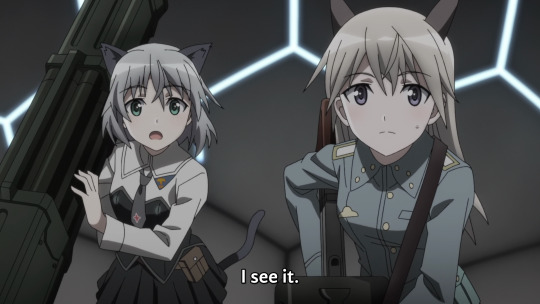
You know the shit’s hit the fan when Sanya, of all people, does this.
Oh, and let’s not forget: it was Eila and Sanya who finished off the dome! I’m not sure why everyone else decided to just fly off, but these two have their backs.

Shirley and Lucchini were a solid team. I liked how each of their personalities shone through in their mannerisms and dialogue, with Shirley being calm, perceptive and responsible, as well as looking out for Lucchini. She also made a good guess at Wolf’s hiding place.
Lucchini, meanwhile, was her adorable hyper self, chafing at the narrow tunnels which prevented her from bouncing around, and later, gleefully taking out one Neuroi tower, only to realize she was shooting at the wrong thing, and being utterly unconcerned as she switched targets. Nyroom! She’s such a playful kid.
I also really liked it when Wolf was running away, and Lucchini immediately looked to Shirley to chase it, but Shirley realized she couldn’t catch it from that distance. She’s come to understand her limits over the course of the series, which pairs well with her increased sense of responsibility in RtB.

Lynne and Perrine were once again the support squad, looking out for Shizuka and later on being quite attuned to anything regarding Yoshika. Unfortunately, they didn’t do much else of note, but that’s been a bit of a pattern for them since Episode 8. Either way, I’ll save my thoughts on that for the full season review. (Yes, I’m going to rant about the season in its entirety next. No one is surprised.)

Erica mostly fell into the same support role as Lynne and Perrine this episode, but she did make the highly useful observation of the anomaly in Germania: the big central building that hadn’t been in the plans. And of course, she was one of the determined Karlslander Witches who chased Wolf at the end, limits be damned.

Hey, while we’re on this pic: I’m pretty sure Mio has spent more time with Ursula than with Minna this season. How crazy is that?!
Mio was also here. I’m sad that we didn’t get a Mio Laugh, not even one at the end. I did enjoy how concerned she was about Shizuka’s well-being though; Mio is like Trude in that she’s quite married to her job (she’s even worse about that than Trude), and so her personal feelings can sometimes end up left behind. But she was still doing everything she could to help her friends, and she was genuinely terrified when she realized Shizuka was about to do something dangerous.
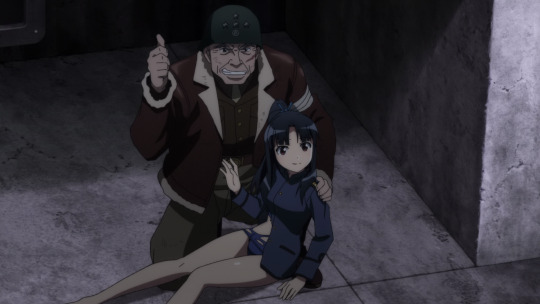
Before I forget, I even have to give a slight nod to Patton. He was good in this episode! Even though he loaded up his revolver, he never actually ended up using it; instead, he was a good supporting character. Even his “GODDAMU” was endearing!

Last but certainly not least, Minna and Trude were, again, excellent. I really loved how they worked together this episode: forming a united front when they told Shizuka she had to stay behind (like two parents telling their new kid to do what’s best for her, ha), and Minna using her reasoning and magic to navigate them through the tunnels while Trude smashed stuff.
Ah yes, Trude. Lovely, lovely Trude. When I wrote about Episode 11, I expressed bewilderment at her sudden suggestion of using the underground tunnels. How did she come by this information? Why did Minna not know? But Episode 12 had my back; Erica asked her about it almost immediately, and as it turned out, Trude had the most adorable reason of all time OMG:

All is forgiven, show. All is forgiven. The fact Trude learned everything about a subway system in a city Chris never even lived in, just to engage with her sister’s interests, is so downright cute and awesome that my love for her has once again increased to previously unimaginable levels. And she memorized it all so damn well that she planned out an entire route into the dome for them! This is the best thing ever!

I was also so, so happy for Minna at the end! In previous seasons, it was always Yoshika who dealt the final blow to their antagonist, but here, Yoshika only prevented Wolf from running away. It was Trude and Erica who pierced its defenses, and it was Minna who went in for the kill. Not only is this amazingly cathartic for her, it’s also something Minna 100% earned in this season. Episode 9 did so well in showing us how badly Minna wanted this, to secure victory for her girls and for herself, to the point where she disregarded her own views on self-sacrifice. And now here she was, maybe in the last sortie of her career, and she received the sweetest reward of all.
...Except the promised coffee in Berlin, which we never got! But that’s okay; this episode already did so much in its runtime, I can’t fault it for not showing us something that would take some time to happen.

Instead, we got something equally satisfying, and something I loved about the ending: it showed us everyone working hard to rebuild Berlin after the battle. RtB has been so good at details, at continuity and consequences, and here, we see that life moves on. Berlin is in ruins, and it’s going to take a lot of elbow grease to get it and the rest of northern Karlsland back into shape. But with people returning and the 501st doing everything they can to help, reconstruction will surely succeed.

And Perrine will one day conquer the world with her army of adopted children!
Life also moved on in a different way. As it turned out (or maybe I just forgot about this?), Wolf was one of two hives in Karlsland. The other one is located somewhere in the south, and thus, the 501st continues their battle for peace. I wonder if this means we’ll get more 501st content down the line? It hasn’t been ruled out, and it’d be amazing to see where these girls go next. (I demand more coffee scenes!)
#strike witches#road to berlin#funnily enough: there's one continuity error in this episode#RtB's usually so good at preventing this (except when that Neuroi tried to ram Lucchini in Episode 4)#anyway: when Trude punches through the wall into the dome's underbelly she's only carrying one gun#but no one else is carrying it for her#and pretty soon afterward she has two guns again#maybe her butt really is a pocket dimension!
6 notes
·
View notes
Note
du hast vor ner Weile nach soften headcanons gefragt und ich weiß nicht, wie gut du Emil und die Detektive (2001) kennst, aber ich hab den gestern mit @mondfahrt geschaut und kann jetzt nicht aufhören, über Crossovers nachzudenken, egal wie random 😅
Pony Hütchen ist halt definitiv schonmal nonbinary, das ist quasi so gut wie canon. Sie benutzt sie und dey/dem Pronomen und datet später Trude Bogolowski, die nach Berlin zieht und in dem Restaurant von Ponys Vater jobbt.
Gustav Hummel my beloved und Sebastian Kreuzkamm wären eine explosive Mischung, die ich mir nicht entgehen lassen will.
Und weil ich das Ende von Emil und die Detektive unnötig heteronormativ finde (literally? Emils Vater und Pastorin Hummel interagieren den ganzen Film lang nicht, er hat sehr viel mehr Chemistry mit ihrem Bruder, aber trotzem muss er mit einem Arm um sie gelegt weglaufen? so weird!!), hab ich beschlossen, dass Pastorin Hummel und dfk Kathrin sich Ende der 80er auf einer Montagsdemo in Leipzig kennengelernt und gebondet haben. Pastorin Hummel war damals allerdings frisch verheiratet oder verlobt oder so, und Kathrin hat ihr Flirten schnell eingestellt, als sie das gemerkt hat. Jahre später treffen sie wieder zufällig aufeinander und plötzlich, chaotischerweise, funkt es zwischen den beiden (wieder).
super random nieschige headcanons, here you go! 😅🙈 (ich hoffe, du kannst mit Emil und die Detektive was anfangen, sonst ist das alles ein bisschen äh. unsinnig^^)
Oh my god!!! Fred, my love, my guy, my dude!!!
Bin gerade beim drafts sauber machen hierauf gestoßen und ich hab vollkommen vergessen, den jemals fertigzustellen. Es tut mir so leid, keine Ahnung wie das passieren konnte 😭 Das macht ich gerade sehr traurig, aber auch sehr glücklich, weil ich mir jetzt dieses wunderbare ask anschauen kann! <3
Allerdings hast du bei einer Sache sehr großes Glück gehabt: denn ich kenne nicht nur Emil und die Detektive (2001), das war sogar einer meiner, wenn nicht sogar mein, Lieblingsfilm als Kind, also bin ich quasi Expertin 🤩
six year old me fühlt sich im übrigen von deiner anmerkung zu pastorin hummel und herr tischbein sehr sehr gesehen, denn das hat mich als kind schon so sehr verwirrt. like for real, die kennen sich so… einen halben tag?? woher kommt das? ich hab komplett vergessen, wie viel chemistry zwischen dem vater und emils lehrer ist, aber schon allein die tatsache, dass der lehrer auch einfach beschließt, emil solange unter seine fittiche zu nehmen (auch wenn das heißt, ihn einfach mal zu seiner schwester nach berlin alleine zu schicken), spricht ja doch schon irgendwie dafür, dass sich der lehrer und emils vater nahe stehen… who really knows 👀 ich bin ja bekanntlich offen für ideen.
aber ich mag die idee von pastorin hummel zusammen mit kathrin unglaublich sehr, vielleicht kennt johann ja den bruder aus dem studium und/oder hat ihn mal gedatet oder so und daher kennen sich die beiden um ein paar ecken. oder kathrin und sie haben auch zusammen studiert, zwischen beiden ist immer irgendwie etwas, aber so ganz gehen sie nie daraufein und dann ist pastorin hummel verlobt und zieht nach berlin. und ohnehin pastorin hummel war immer ein bisschen lost, weil sie auch ein bisschen verwirrt von kathrins und johanns beziehung war und dann reden die zwei miteinander darüber, wenn sie sich jahre später nochmal treffen. okay, irgendwie würde ja jetzt auch nichts dagegen sprechen es mal überhaupt miteinander zu versuchen.
aber wirklich sapphic anja kling, i didnt know i need it that much, danke dass du dieses konzept ins leben gerufen hast <333
sebastian kreuzkamm und gustav hummel kennen sich bestimmt von irgendeinem schulischem förderprogramm (oder durch die kirche lmao) und haben sich erstmal gegenseitig angebitcht, um dann später festzustellen, dass sie eigentlich sehr gut miteinander klarkommen
und das beste habe ich mit zum schluss aufgehoben, weil JA, JA, JA UND NOCHMALS JA dey/dem Pony Hütchen ist so gut, we love to see it 🫶 lieb die idee von dem crossover, trude bringt pony dann auch mal mit, um dem hühner und pygmäen vorzustellen und ich glaube torte und pony wären auch eine absolut wilde kombi.
danke danke, dass du mir diese ask geschickt hast, auch wenn es echt eine halbe ewigkeit her ist, es hat sehr tolle erinnerungen an diesen film zurückgebracht und ich muss ihn mir definitiv nochmal anschauen und dir dann noch mehr dazu erzählen :DD
#ich werde staubsauger vertreter!!!#musste gerade wieder an diese iconic stelle denken#der humor in diesem film ist so großartig#silly goofy just how i like it#emil und die detektive#ich liebe den namen emil btw#maybe i should start call myself like that…#ask
10 notes
·
View notes
Photo

Trude Fleischmann Sybille Binder, Berlin c.1928
76 notes
·
View notes
Text
Inspiriert von "Übernatürlich" präsentiere ich stolz bzw. beschämt:
Die Magnus-Archive - Aussagen der Angst
Johannes Simmitz vom altgedienten Magnus-Institut in Berlin-Mitte hat sich für eine freie Stelle in der Archivleitung beworben, und sie tatsächlich bekommen. Es scheint, als wäre der schmierige, vapende Institutsleiter Elias Burghardt darauf erpicht, die verstorbene Archivarin Trude Robinson schnell zu ersetzen.
Johannes ist geschockt vom Chaos im Archiv, das natürlich keinerlei technische Geräte besitzt, die jünger als 1975 sind. Immerhin hilft ihm die Archiv-Assistenz: die pfiffige Sara Jakob, der charmante Hipster "Timmi" Stöcher und der stille, tollpatschige Nerd Martin Schwartzholz unterstützen Johannes, so gut sie können.
*Klick*
"Beginn der Aussage."
#hat jemand Vorschläge fur Synchronsprecher?#deutsch#german#tma#the magnus archives#magnus#magnus podcast#Johnathan sims#rusty quill
13 notes
·
View notes
Video
tumblr
Much of the emotional impact of the film, for the audience in 1942, has been attributed to the large proportion of European exiles and refugees who were extras or played minor roles (in addition to leading actors Paul Henreid, Conrad Veidt and Peter Lorre), such as Louis V. Arco, Trude Berliner, Ilka Grünig, Ludwig Stössel, Hans Heinrich von Twardowski, and Wolfgang Zilzer. A witness to the filming of the "duel of the anthems" sequence said he saw many of the actors crying and "realized that they were all real refugees". Harmetz argues that they "brought to a dozen small roles in Casablanca an understanding and a desperation that could never have come from Central Casting". Even though many were Jewish or refugees from the Nazis (or both), they were frequently cast as Nazis in various war films, because of their accents.
5 notes
·
View notes
Text

Hedy Lamarr, born Hedwig Eva Maria Kiesler (November or September 9, 1914 – January 19, 2000), was an Austrian-American actress, inventor, and film producer. She appeared in 30 films over a 28 year career, and co-invented an early version of frequency-hopping spread spectrum communication.
Lamarr was born in Vienna, Austria-Hungary, and acted in a number of Austrian, German, and Czech films in her brief early film career, including the controversial Ecstasy (1933). In 1937, she fled from her husband, a wealthy Austrian ammunition manufacturer, secretly moving to Paris and then on to London. There she met Louis B. Mayer, head of Metro-Goldwyn-Mayer (MGM) studio, who offered her a Hollywood movie contract, where he began promoting her as "the world's most beautiful woman".
She became a star through her performance in Algiers (1938), her first United States film.[5] She starred opposite Clark Gable in Boom Town and Comrade X (both 1940), and James Stewart in Come Live with Me and Ziegfeld Girl (both 1941). Her other MGM films include Lady of the Tropics (1939), H.M. Pulham, Esq. (1941), as well as Crossroads and White Cargo (both 1942); she was also borrowed by Warner Bros. for The Conspirators, and by RKO for Experiment Perilous (both 1944). Dismayed by being typecast, Lamarr co-founded a new production studio and starred in its films: The Strange Woman (1946), and Dishonored Lady (1947). Her greatest success was as Delilah in Cecil B. DeMille's Samson and Delilah (1949). She also acted on television before the release of her final film, The Female Animal (1958). She was honored with a star on the Hollywood Walk of Fame in 1960.
At the beginning of World War II, Lamarr and composer George Antheil developed a radio guidance system using frequency-hopping spread spectrum technology for Allied torpedoes, intended to defeat the threat of jamming by the Axis powers. She also helped improve aircraft aerodynamics for Howard Hughes while they dated during the war. Although the US Navy did not adopt Lamarr and Antheil's invention until 1957, various spread-spectrum techniques are incorporated into Bluetooth technology and are similar to methods used in legacy versions of Wi-Fi. Recognition of the value of their work resulted in the pair being posthumously inducted into the National Inventors Hall of Fame in 2014.
Lamarr was born Hedwig Eva Maria Kiesler in 1914 in Vienna, Austria-Hungary, the only child of Emil Kiesler (1880–1935) and Gertrud "Trude" Kiesler (née Lichtwitz; 1894–1977). Her father was born to a Galician-Jewish family in Lemberg (now Lviv, Ukraine), and was a successful bank manager. Her mother was a pianist, born in Budapest to an upper-class Hungarian-Jewish family. She converted to Catholicism as an adult, at the insistence of her first husband, and raised her daughter Hedy as a Catholic as well, though she was not formally baptized at the time.
As a child, Kiesler showed an interest in acting and was fascinated by theatre and film. At the age of 12, she won a beauty contest in Vienna. She also began to associate invention with her father, who would take her out on walks, explaining how various technologies in society functioned.
After the Anschluss, she helped get her mother out of Austria and to the United States, where Gertrud Kiesler later became an American citizen. She put "Hebrew" as her race on her petition for naturalization, a term that had been frequently used in Europe.
Still using her maiden name of Hedy Kiesler, she took acting classes in Vienna. One day, she forged a permission note from her mother and went to Sascha-Film, where she was hired at the age of 16 as a script girl. She gained a role as an extra in Money on the Street (1930), and then a small speaking part in Storm in a Water Glass (1931). Producer Max Reinhardt cast her in a play entitled The Weaker Sex, which was performed at the Theater in der Josefstadt. Reinhardt was so impressed with her that he arranged for her to return with him to Berlin, where he was based.
Kiesler never trained with Reinhardt nor appeared in any of his Berlin productions. After meeting Russian theatre producer Alexis Granowsky, she was cast in his film directorial debut, The Trunks of Mr. O.F. (1931), starring Walter Abel and Peter Lorre. Granowsky soon moved to Paris, but Kiesler stayed in Berlin to work. She was given the lead role in No Money Needed (1932), a comedy directed by Carl Boese. Her next film brought her international fame.
In early 1933, at age 18, Hedy Kiesler, still working under her maiden name, was given the lead in Gustav Machatý's film Ecstasy (Ekstase in German, Extase in Czech). She played the neglected young wife of an indifferent older man.
The film became both celebrated and notorious for showing the actress's face in the throes of an orgasm. According to Marie Benedict's book The Only Woman In The Room, Kiesler's expression resulted from someone sticking her with a pin. She was also shown in closeups and brief nude scenes, the latter reportedly a result of the actress being "duped" by the director and producer, who used high-power telephoto lenses.
Although Kiesler was dismayed and now disillusioned about taking other roles, Ecstasy gained world recognition after winning an award in Rome. Throughout Europe, the film was regarded as an artistic work. However, in the United States, it was banned, considered overly sexual, and made the target of negative publicity, especially among women's groups. It was also banned in Germany due to Kiesler's Jewish heritage. Her husband, Fritz Mandl, reportedly spent over $300,000 buying up and destroying copies of the film.
Kiesler also played a number of stage roles, including a starring one in Sissy, a play about Empress Elisabeth of Austria produced in Vienna in early 1933, just as Ecstasy premiered. It won accolades from critics.
Admirers sent roses to her dressing room and tried to get backstage to meet Kiesler. She sent most of them away, including an insistent Friedrich Mandl. He became obsessed with getting to know her. Mandl was a Viennese arms merchant and munitions manufacturer who was reputedly the third-richest man in Austria. She fell for his charming and fascinating personality, partly due to his immense wealth. Her parents, both of Jewish descent, did not approve, as Mandl had ties to Italian fascist leader Benito Mussolini, and later, German Führer Adolf Hitler, but they could not stop their headstrong daughter.
On August 10, 1933, at the age of 18, Kiesler married Mandl, then 33. The son of a Jewish father and a Catholic mother, Mandl insisted that she convert to Catholicism before their wedding in Vienna Karlskirche. In her autobiography Ecstasy and Me, Mandl is described as an extremely controlling husband. He strongly objected to her having been filmed in the simulated orgasm scene in Ecstasy and prevented her from pursuing her acting career. She claimed she was kept a virtual prisoner in their castle home, Castle Schwarzenau in the remote Waldviertel near the Czech border.
Mandl had close social and business ties to the Italian government, selling munitions to the country, and, despite his own part-Jewish descent, had ties to the Nazi regime of Germany. Kiesler accompanied Mandl to business meetings, where he conferred with scientists and other professionals involved in military technology. These conferences were her introduction to the field of applied science and she became interested in nurturing her latent talent in science.
Finding her marriage to Mandl eventually unbearable, Kiesler decided to flee her husband as well as her country. According to her autobiography, she disguised herself as her maid and fled to Paris. Friedrich Otto's account says that she persuaded Mandl to let her wear all of her jewelry for a dinner party where the influential austrofascist Ernst Stahremberg attended, then disappeared afterward. She writes about her marriage:
I knew very soon that I could never be an actress while I was his wife. ... He was the absolute monarch in his marriage. ... I was like a doll. I was like a thing, some object of art which had to be guarded—and imprisoned—having no mind, no life of its own.
After arriving in London in 1937, she met Louis B. Mayer, head of MGM, who was scouting for talent in Europe. She initially turned down the offer he made her (of $125 a week), but booked herself onto the same New York-bound liner as he. During the trip, she impressed him enough to secure a $500 a week contract. Mayer persuaded her to change her name from Hedwig Kiesler (to distance herself from "the Ecstasy lady" reputation associated with it). She chose the surname "Lamarr" in homage to the beautiful silent film star, Barbara La Marr, on the suggestion of Mayer's wife, Margaret Shenberg.
When Mayer brought Lamarr to Hollywood in 1938, he began promoting her as the "world's most beautiful woman". He introduced her to producer Walter Wanger, who was making Algiers (1938), an American version of the noted French film, Pépé le Moko (1937).
Lamarr was cast in the lead opposite Charles Boyer. The film created a "national sensation", says Shearer. Lamarr was billed as an unknown but well-publicized Austrian actress, which created anticipation in audiences. Mayer hoped she would become another Greta Garbo or Marlene Dietrich. According to one viewer, when her face first appeared on the screen, "everyone gasped ... Lamarr's beauty literally took one's breath away."
In future Hollywood films, Lamarr was often typecast as the archetypal glamorous seductress of exotic origin. Her second American film was I Take This Woman (1940), co-starring with Spencer Tracy under the direction of regular Dietrich collaborator, Josef von Sternberg. Von Sternberg was fired during the shoot, and replaced by Frank Borzage. The film was put on hold, and Lamarr was put into Lady of the Tropics (1939), where she played a mixed-race seductress in Saigon opposite Robert Taylor. She returned to I Take This Woman, re-shot by W. S. Van Dyke. The resulting film was a flop.
Far more popular was Boom Town (1940) with Clark Gable, Claudette Colbert and Spencer Tracy; it made $5 million MGM promptly reteamed Lamarr and Gable in Comrade X (1940), a comedy film in the vein of Ninotchka (1939), which was another hit.
She was teamed with James Stewart in Come Live with Me (1941), playing a Viennese refugee. Stewart was also featured in Ziegfeld Girl (1941), in which Lamarr, Judy Garland, and Lana Turner played aspiring showgirls; it was a big success.
Lamarr was top-billed in H. M. Pulham, Esq. (1941), although the film's protagonist was the title role played by Robert Young. She made a third film with Tracy, Tortilla Flat (1942). It was successful at the box office, as was Crossroads (1942) with William Powell.
She played the seductive native girl Tondelayo in White Cargo (1942), top-billed over Walter Pidgeon. It was a huge hit. White Cargo contains arguably her most memorable film quote, delivered with provocative invitation: "I am Tondelayo. I make tiffin for you?" This line typifies many of Lamarr's roles, which emphasized her beauty and sensuality while giving her relatively few lines. The lack of acting challenges bored Lamarr, and she reportedly took up inventing to relieve her boredom. In a 1970 interview, Lamarr also remarked that she was paid less because she would not sleep with Mayer.
Lamarr was reunited with Powell in a comedy, The Heavenly Body (1944). She was then borrowed by Warner Bros. for The Conspirators (1944), reuniting several of the actors of Casablanca (1942), which had been inspired in part by Algiers and written with Lamarr in mind as its female lead, though MGM would not lend her out. RKO later borrowed her for a melodrama, Experiment Perilous (1944), directed by Jacques Tourneur.
Back at MGM, Lamarr was teamed with Robert Walker in the romantic comedy Her Highness and the Bellboy (1945), playing a princess who falls in love with a New Yorker. It was very popular, but would be the last film she made under her MGM contract.
Her off-screen life and personality during those years was quite different from her screen image. She spent much of her time feeling lonely and homesick. She might swim at her agent's pool, but shunned the beaches and staring crowds. When asked for an autograph, she wondered why anyone would want it. Writer Howard Sharpe interviewed her and gave his impression:
Hedy has the most incredible personal sophistication. She knows the peculiarly European art of being womanly; she knows what men want in a beautiful woman, what attracts them, and she forces herself to be these things. She has magnetism with warmth, something that neither Dietrich nor Garbo has managed to achieve.
Author Richard Rhodes describes her assimilation into American culture:
Of all the European émigrés who escaped Nazi Germany and Nazi Austria, she was one of the very few who succeeded in moving to another culture and becoming a full-fledged star herself. There were so very few who could make the transition linguistically or culturally. She really was a resourceful human being–I think because of her father's strong influence on her as a child.
Lamarr also had a penchant for speaking about herself in the third person.
Lamarr wanted to join the National Inventors Council, but was reportedly told by NIC member Charles F. Kettering and others that she could better help the war effort by using her celebrity status to sell war bonds.
She participated in a war bond-selling campaign with a sailor named Eddie Rhodes. Rhodes was in the crowd at each Lamarr appearance, and she would call him up on stage. She would briefly flirt with him before asking the audience if she should give him a kiss. The crowd would say yes, to which Hedy would reply that she would if enough people bought war bonds. After enough bonds were purchased, she would kiss Rhodes and he would head back into the audience. Then they would head off to the next war bond rally. In total, Lamarr sold approximately $25 million (over $350 million when adjusted for inflation in 2020) worth of war bonds during a period of 10 days.
After leaving MGM in 1945, Lamarr formed production company Mars Film Corporation with Jack Chertok and Hunt Stromberg, producing two film noir motion pictures which she also starred in: The Strange Woman (1946) as a manipulative seductress leading a son to murder his father, and Dishonored Lady (1947) as a formerly suicidal fashion designer[verification needed] trying to start a new life but gets accused of murder. Her initiative was unwelcomed by the Hollywood establishment, as they were against actors (especially female actors) producing their films independently. Both films grossed over their budgets, but were not large commercial successes.
In 1948, she tried a comedy with Robert Cummings, called Let's Live a Little.
Lamarr enjoyed her greatest success playing Delilah opposite Victor Mature as the biblical strongman in Cecil B. DeMille's Samson and Delilah (1949). A massive critical and commercial success, the film became the highest-grossing picture of 1950 and won two Academy Awards (Best Art Direction and Best Costume Design) of its five nominations. She won critical acclaim for her portrayal of Delilah. Showmen's Trade Review previewed the film before its release and commended Lamarr's performance: "Miss Lamarr is just about everyone's conception of the fair-skinned, dark-haired, beauteous Delilah, a role tailor-made for her, and her best acting chore to date."[48] Photoplay wrote, "As Delilah, Hedy Lamarr is treacherous and tantalizing, her charms enhanced by Technicolor."[49]
Lamarr returned to MGM for a film noir with John Hodiak, A Lady Without Passport (1950), which flopped. More popular were two pictures she made at Paramount, a Western with Ray Milland, Copper Canyon (1950), and a Bob Hope spy spoof, My Favorite Spy (1951).
Her career went into decline. She went to Italy to play multiple roles in Loves of Three Queens (1954), which she also produced. However she lacked the experience necessary to make a success of such an epic production, and lost millions of dollars when she was unable to secure distribution of the picture.
She was Joan of Arc in Irwin Allen's critically panned epic, The Story of Mankind (1957) and did episodes of Zane Grey Theatre ("Proud Woman") and Shower of Stars ("Cloak and Dagger"). Her last film was a thriller The Female Animal (1958).
Lamarr was signed to act in the 1966 film Picture Mommy Dead, but was let go when she collapsed during filming from nervous exhaustion. She was replaced in the role of Jessica Flagmore Shelley by Zsa Zsa Gabor.
Although Lamarr had no formal training and was primarily self-taught, she worked in her spare time on various hobbies and inventions, which included an improved traffic stoplight and a tablet that would dissolve in water to create a carbonated drink. The beverage was unsuccessful; Lamarr herself said it tasted like Alka-Seltzer.
Among the few who knew of Lamarr's inventiveness was aviation tycoon Howard Hughes. She suggested he change the rather square design of his aeroplanes (which she thought looked too slow) to a more streamlined shape, based on pictures of the fastest birds and fish she could find. Lamarr discussed her relationship with Hughes during an interview, saying that while they dated, he actively supported her inventive "tinkering" hobbies. He put his team of scientists and engineers at her disposal, saying they would do or make anything she asked for.
During World War II, Lamarr learned that radio-controlled torpedoes, an emerging technology in naval war, could easily be jammed and set off course.[53] She thought of creating a frequency-hopping signal that could not be tracked or jammed. She conceived an idea and contacted her friend, composer and pianist George Antheil, to help her implement it.[54] Together they developed a device for doing that, when he succeeded by synchronizing a miniaturized player-piano mechanism with radio signals.[40] They drafted designs for the frequency-hopping system, which they patented.[55][56] Antheil recalled:
We began talking about the war, which, in the late summer of 1940, was looking most extremely black. Hedy said that she did not feel very comfortable, sitting there in Hollywood and making lots of money when things were in such a state. She said that she knew a good deal about munitions and various secret weapons ... and that she was thinking seriously of quitting MGM and going to Washington, D.C., to offer her services to the newly established National Inventors Council.
As quoted from a 1945 Stars and Stripes interview, "Hedy modestly admitted she did only 'creative work on the invention', while the composer and author George Antheil, 'did the really important chemical part'. Hedy was not too clear about how the device worked, but she remembered that she and Antheil sat down on her living room rug and were using a silver match box with the matches simulating the wiring of the invented 'thing'. She said that at the start of the war 'British fliers were over hostile territory as soon as they crossed the channel, but German aviators were over friendly territory most of the way to England... I got the idea for my invention when I tried to think of some way to even the balance for the British. A radio controlled torpedo, I thought would do it.'"
Their invention was granted a patent under U.S. Patent 2,292,387 on August 11, 1942 (filed using her married name Hedy Kiesler Markey).[58] However, it was technologically difficult to implement, and at the time the US Navy was not receptive to considering inventions coming from outside the military.[35] Nevertheless, it was classified in the "red hot" category.[59] It was first adapted in 1957 to develop a sonobuoy before the expiration of the patent, although this was denied by the Navy. At the time of the Cuban Missile Crisis in 1962, an updated version of their design was installed on Navy ships.[60] Today, various spread-spectrum techniques are incorporated into Bluetooth technology and are similar to methods used in legacy versions of Wi-Fi. Lamarr and Antheil's contributions were formally recognized in the late twentieth and early twenty-first centuries.
Lamarr was married and divorced six times and had three children:
Friedrich Mandl (married 1933–37), chairman of the Hirtenberger Patronen-Fabrik
Gene Markey (married 1939–41), screenwriter and producer. She adopted a boy, James Lamarr Markey (born January 9, 1939) during her marriage with Markey. In 2001, James found out he was the out-of-wedlock son of Lamarr and actor John Loder, whom she later married as her third husband.
John Loder (married 1943–47), actor. James Lamarr Markey was adopted by Loder as James Lamarr Loder. During the marriage, Lamarr and Loder also had two further children: Denise Loder (born January 19, 1945), married Larry Colton, a writer and former baseball player; and Anthony Loder (born February 1, 1947), married Roxanne who worked for illustrator James McMullan. They both appeared in the documentary films Calling Hedy Lamarr (2004), and Bombshell: The Hedy Lamarr Story (2017).
Ernest "Ted" Stauffer (married 1951–52), nightclub owner, restaurateur, and former bandleader
W. Howard Lee (married 1953–60), a Texas oilman (he later married film actress Gene Tierney)
Lewis J. Boies (married 1963–65), Lamarr's divorce lawyer
Following her sixth and final divorce in 1965, Lamarr remained unmarried for the last 35 years of her life.
Lamarr became a naturalized citizen of the United States at age 38 on April 10, 1953. Her autobiography, Ecstasy and Me, was published in 1966. In a 1969 interview on The Merv Griffin Show, she said that she did not write it and claimed that much was fictional. Lamarr sued the publisher in 1966 to halt publication, saying that many details were fabricated by its ghost writer, Leo Guild. She lost the suit. In 1967, Lamarr was sued by Gene Ringgold, who asserted that the book plagiarized material from an article he had written in 1965 for Screen Facts magazine.
In the late 1950s, Lamarr designed and, with husband W. Howard Lee, developed the Villa LaMarr ski resort in Aspen, Colorado. After their divorce, her husband gained this resort
In 1966, Lamarr was arrested in Los Angeles for shoplifting. The charges were eventually dropped. In 1991, she was arrested on the same charge in Florida, this time for stealing $21.48 worth of laxatives and eye drops. She pleaded no contest to avoid a court appearance, and the charges were dropped in return for her promise to refrain from breaking any laws for a year.
During the 1970s, Lamarr lived in increasing seclusion. She was offered several scripts, television commercials, and stage projects, but none piqued her interest. In 1974, she filed a $10 million lawsuit against Warner Bros., claiming that the running parody of her name ("Hedley Lamarr") featured in the Mel Brooks comedy Blazing Saddles infringed her right to privacy. Brooks said he was flattered; the studio settled out of court for an undisclosed nominal sum and an apology to Lamarr for "almost using her name". Brooks said that Lamarr "never got the joke". With her eyesight failing, Lamarr retreated from public life and settled in Miami Beach, Florida, in 1981.
In 1996, a large Corel-drawn image of Lamarr won the annual cover design contest for the CorelDRAW's yearly software suite. For several years, beginning in 1997, it was featured on boxes of the software suite. Lamarr sued the company for using her image without her permission. Corel countered that she did not own rights to the image. The parties reached an undisclosed settlement in 1998.
In 1997, Canadian company WiLAN signed an agreement with Lamarr to acquire 49% of the marketing rights of her patent, and a right of first refusal for the remaining 51% for ten quarterly payments. This was the only financial compensation she received for her frequency-hopping spread spectrum invention. A friendship ensued between her and the company's CEO, Hatim Zaghloul.
Lamarr became estranged from her son, James Lamarr Loder (who believed he was adopted until 2001), when he was 12 years old. Their relationship ended abruptly, and he moved in with another family. They did not speak again for almost 50 years. Lamarr left James Loder out of her will, and he sued for control of the US$3.3 million estate left by Lamarr in 2000. He eventually settled for US$50,000. James Loder was the Omaha, Nebraska police officer who was charged but then acquitted of the killing of 14 year old Vivian Strong in 1969.
In the last decades of her life, Lamarr communicated only by telephone with the outside world, even with her children and close friends. She often talked up to six or seven hours a day on the phone, but she spent hardly any time with anyone in person in her final years. A documentary film, Calling Hedy Lamarr, was released in 2004 and features her children Anthony Loder and Denise Loder-DeLuca.
Lamarr died in Casselberry, Florida, on January 19, 2000, of heart disease, aged 85. According to her wishes, she was cremated and her son Anthony Loder spread her ashes in Austria's Vienna Woods.
In 1939, Lamarr was voted the "most promising new actress" of 1938 in a poll of area voters conducted by a Philadelphia Record film critic.[95]
In 1951, British moviegoers voted Lamarr the tenth best actress of 1950,[96] for her performance in Samson and Delilah.
In 1960, Lamarr was honored with a star on the Hollywood Walk of Fame for her contribution to the motion picture industry, at 6247 Hollywood Blvd adjacent to Vine Street where the walk is centered.
In 1997, Lamarr and George Antheil were jointly honored with the Electronic Frontier Foundation's Pioneer Award.
Also in 1997, Lamarr was the first woman to receive the Invention Convention's BULBIE Gnass Spirit of Achievement Award, known as the "Oscars of inventing".
In 2014, Lamarr and Antheil were posthumously inducted into the National Inventors Hall of Fame for frequency-hopping spread spectrum technology.
Also in 2014, Lamarr was given an honorary grave in Vienna's Central Cemetery, where the remaining portion of her ashes were buried in November, shortly before her 100th birthday.
Asteroid 32730 Lamarr, discovered by Karl Reinmuth at Heidelberg Observatory in 1951, was named in her memory. The official naming citation was published by the Minor Planet Center on August 27, 2019 (M.P.C. 115894).
On 6 November 2020, a satellite named after her (ÑuSat 14 or "Hedy", COSPAR 2020-079F) was launched into space.
The 2004 documentary film Calling Hedy Lamarr features her children, Anthony Loder and Denise Loder-DeLuca.
In 2010, Lamarr was selected out of 150 IT people to be featured in a short film launched by the British Computer Society on May 20.
Also during 2010, the New York Public Library exhibit Thirty Years of Photography at the New York Public Library included a photo of a topless Lamarr (c. 1930) by Austrian-born American photographer Trude Fleischmann.
The 2017 documentary film Bombshell: The Hedy Lamarr Story, written and directed by Alexandra Dean and produced by Susan Sarandon,[108] about Lamarr's life and career as an actress and inventor, also featuring her children Anthony and Denise, among others, premiered at the 2017 Tribeca Film Festival.[40] It was released in theaters on November 24, 2017, and aired on the PBS series American Masters in May 2018. As of April 2020, it is also available on Netflix.
During World War II, the Office of Strategic Services invented a pyrotechnic device meant to help agents operating behind enemy lines to escape if capture seemed imminent. When the pin was pulled, it made the whistle of a falling bomb followed by a loud explosion and a large cloud of smoke, enabling the agent to make his escape. It saved the life of at least one agent. The device was codenamed the Hedy Lamarr.[109]
The Mel Brooks 1974 western parody Blazing Saddles features a male villain named "Hedley Lamarr". As a running gag, various characters mistakenly refer to him as "Hedy Lamarr" prompting him to testily reply "That's Hedley."
In the 1982 off-Broadway musical Little Shop of Horrors and subsequent film adaptation (1986), Audrey II says to Seymour in the song "Feed Me" that he can get Seymour anything he wants, including "A date with Hedy Lamarr."
On the Nickelodeon show Hey Arnold!, there is a running gag in which whenever something unfortunate happens to Arnold's grandfather, Phil, he constantly states how things would have been different if he had "married Hedy Lamarr instead!". In one episode, it is revealed that he carries a photo of her in his wallet.
In the 2003 video game Half-Life 2, Dr. Kleiner's pet headcrab, Lamarr, is named after Hedy Lamarr.
In 2008, an off-Broadway play, Frequency Hopping, features the lives of Lamarr and Antheil. The play was written and staged by Elyse Singer, and the script won a prize for best new play about science and technology from STAGE.
In 2011, the story of Lamarr's frequency-hopping spread spectrum invention was explored in an episode of the Science Channel show Dark Matters: Twisted But True, a series that explores the darker side of scientific discovery and experimentation, which premiered on September 7.
Batman co-creator Bob Kane was a great movie fan and his love for film provided the impetus for several Batman characters, among them, Catwoman. Among Kane's inspiration for Catwoman were Lamarr and actress Jean Harlow. Also in 2011, Anne Hathaway revealed that she had learned that the original Catwoman was based on Lamarr, so she studied all of Lamarr's films and incorporated some of her breathing techniques into her portrayal of Catwoman in the 2012 film The Dark Knight Rises.
In 2013, her work in improving wireless security was part of the premiere episode of the Discovery Channel show How We Invented the World.
In 2015, on November 9, the 101st anniversary of Lamarr's birth, Google paid tribute to Lamarr's work in film and her contributions to scientific advancement with an animated Google Doodle.
In 2016, Lamarr was depicted in an off-Broadway play, HEDY! The Life and Inventions of Hedy Lamarr, a one-woman show written and performed by Heather Massie.
Also in 2016, the off-Broadway, one-actor show Stand Still and Look Stupid: The Life Story of Hedy Lamarr starring Emily Ebertz and written by Mike Broemmel went into production.
Also in 2016, Whitney Frost, a character in the TV show Agent Carter, was inspired by Lamarr and Lauren Bacall.
In 2017, actress Celia Massingham portrayed Lamarr on The CW television series Legends of Tomorrow in the sixth episode of the third season, titled "Helen Hunt". The episode is set in 1937 "Hollywoodland" and references Lamarr's reputation as an inventor. The episode aired on November 14, 2017.
In 2018, actress Alyssa Sutherland portrayed Lamarr on the NBC television series Timeless in the third episode of the second season, titled "Hollywoodland". The episode aired March 25, 2018.
Gal Gadot is set to portray Lamarr in an Apple TV+ limited series based on her life story.
A novelization of her life, The Only Woman in the Room by Marie Benedict, was published in 2019.
#hedy lamarr#classic hollywood#classic movie stars#golden age of hollywood#old hollywood#1930s hollywood#1940s hollywood#1950s hollywood#hollywood legend
41 notes
·
View notes
Note
Fake Fic title: the love you find at home (which i'm pretty sure is an actual fic title i've seen before, i just can't remember where or what it was about xD). the fandom?? why, die wilden Hühner of course ;)
The Love You Find at Home
Tags: Die Wilden Hühner, Wilma x Trude, friends to lovers, summer romance, mutual pining, oblivious idiots in love, softness, childhood crush revisited, happy ending
Wilma ist frisch zurück aus Berlin, hat endlich ihren Abschluss in Theaterwissenschaften in der Tasche, im Herbst eine Rolle an der Theaterbühne ihrer Träume in Aussicht, sie ist cool, queer und endlich hat sie alles, was sie immer wollte.
Eigentlich alles perfekt, wäre da nicht noch ein endlos scheinender Sommer vor ihr, wo sie ihren Eltern bei der Haushaltsauflösung ihrer kürzlich verstorbenen Großmutter helfen muss. Das ist so gar nicht cool oder queer oder was sie will. In ihrer Heimatstadt war sie seit Ewigkeiten nicht mehr, da hält sie sowieso nichts mehr seit ihre Freunde von damals auch alle in die große weite Welt ausgezogen sind. Wilma bereitet sich schon auf den absolut langweiligsten Sommer ihres Lebens vor, da trifft sie am ersten Tag im Supermarkt zufällig auf Trude, die den Sommer bei ihrer Mutter verbringt. Und vielleicht wird der Sommer ja doch noch cooler und queerer als gedacht und vielleicht gibt es da noch etwas, von dem Wilma noch gar nicht wusste, dass sie es schon immer wollte...
#trude x wilma mutual pining romance?????#nicht sicher was für eine Idee mich grade besessen hat aber damn ist das gut#might fuck around and actually write it#die wilden hühner#sol writes
9 notes
·
View notes
Photo
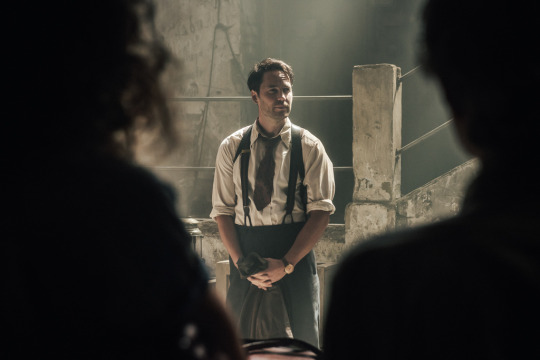
A breakdown of each of the ‘Shadowplay’ episodes to air on ZDF in October. On ZDF the series will be airing as four, two hour episodes. This is a translation from German, so forgive me if there are mistakes.
*SPOILERS* after the cut:
Episode 1:
In 1946, the New York police officer Max McLaughlin traveled to the divided city of Berlin to help set up a civilian police force based on the American model. Max reports to Tom Franklin, the US Vice Consul in Berlin, whose fragile and seductive British wife Claire is immediately drawn to Max. Her appearance at social events, her hatred of Germans and her uninhibited flirtations make her a colorful personality. Max is enchanted, but at the same time senses the danger she poses. On the German side, he works with Chief Inspector Elsie Garten, whose husband is interned in a Russian prisoner-of-war camp. Their task force consists mainly of women and orphans, whose chair legs serve as batons and who have moved into their territory in a disused bank. At the same time he is looking for his missing brother Moritz, with whom he is ominously connected through a traumatic experience in his childhood. But the Russians also cause problems: Max and Elsie barely manage to prevent Russian soldiers from shooting at defenseless German civilians who report to the unscrupulous Russian officer Izosimov. He also does not shy away from torture in order to snatch the information from the youngest member of the police force, the Jewish orphan Gad, which Elsie Garten can use for his purposes - and thus against the Americans. In another part of the city, Karin, who was raped by GIs, asks the Berlin doctor and criminal king Gladow, known as "the angel maker", for an illegal abortion. And for assistance in getting revenge on their tormentors. The price: the collaboration in his dangerous underground organization. Starting with the retaliatory murder of the GIs and followed by the murder of a random eyewitness, Karin gradually changes from a passive victim to an active perpetrator. But Max is not only concerned with the double murder of the GIs, but also with an anonymous tip that leads him to the corpses of an ex-Nazi and his family in an abandoned building. The gruesome act seems like a murderous staging of the first prank from the German children's book "Max and Moritz", with which the two American brothers have happy memories of their German mother. Max's brother Moritz is hiding behind the crime and is taking cruel revenge on Nazis in hiding. When Moritz reveals himself, he demands the oath of loyalty that he once wrested from his little brother: Max should go on a campaign of revenge with him against every law.
Episode 2:
Max receives pressure from his superior and US Vice Consul in Berlin Tom Franklin to investigate the GIs murder as quickly as possible. He himself is driven by the search for his brother Moritz, who he fears that he will strike again. And Moritz actually goes to the bike shop owner Berta Spiel in her shop and kidnaps her. Berta was an overseer in the Dachau camp and Moritz wants to get information about her former backers through her. In the meantime, Max and Elsie interrogate Karin - without knowing how close they are to the GIs murderer. However, immediately after being questioned, Karin went underground in Berlin. She fled to the "angel maker" and offered him her active participation in his organization. As a first assignment, she received the task of channeling information into the eastern sector together with Marianne. There, however, the two women are attacked by Russian soldiers and Marianne is seriously injured. At the same time, the police force observes the hotel "Alt-Bayern", in which "Der Engelmacher" runs a brothel, because they hope to find Karin there. Max meets Moritz's former commander, General Wright. He tells him about the traumatic experiences during the liberation of the Dachau concentration camp, which changed Moritz forever. And again Max receives a personal message from his brother Moritz. This leads him to a warehouse where he finds Berta Spiel, who died from her burns. The procedure is fatally reminiscent of the second prank from the children's book "Max and Moritz". Elsie meets with the Russian officer Izosimov, who gives her the opportunity to see her husband Leopold again - on condition that she provides him with information about Max. Elsie agrees and begins to observe her colleague. But then Max is kidnapped by the Nakam, a secret Jewish organization which, in turn, wages a campaign of revenge against Nazis who have gone underground and wants to win Max over for this.
Episode 3:
The two brothers' game of cat and mouse is drawing ever closer circles. Max doesn't find Moritz himself, but at least his hiding place: He has holed himself up in a boathouse where he abused his youngest victim - Oberlander, a high-ranking Nazi officer. In the meantime, the Jewish auxiliary police officer Gad has found out that Karin is actually staying in the Hotel "Alt-Bayern". When Max and Elsie want to arrest them, Karin fires an anti-aircraft gun at the police force. She manages to flee in the resulting tumult and to warn the "angel maker" about the police in good time. To protect himself, Karin persuades to kill the injured Marianne. She is too weak to flee. Karin does what the diabolical charismatic demands of her - and thereby betrays not only her only friend, but ultimately also herself. Claire visits Max in his hotel room and makes it clear to him that she wants more from him. Max still resists her charm and focuses on the search for his brother. When the two finally meet, the brothers engage in a merciless fight. They hit each other. Max remains unconscious on the floor and Moritz flees. When Max comes to, Oberlander is lying dead next to him. As if reflexively, Max disposed of the body. But he has to admit that his brother can no longer be saved and that he can no longer protect him. Since Karin and "Der Engelmacher" believe that the police have evidence against them in their hands, they plan an attack on the police station - an attack that no one should survive. Leopold in turn tries to escape from Russian captivity and is seriously injured in the process. Elsie asks Izosimov to let her husband go anyway. In return, she offers him to continue to cooperate with him. That same night Leopold tried to flee again with other prisoners. A firing squad kills all refugees. Only Leopold remains alive. At a party at Franklin's house, Max finally gives in to Claire's advances. Neither he nor Claire suspect that Franklin is watching them. And then Moritz shows up at the party - in an American uniform. None of those present took special notice of him. Moritz's goal is still to get his brother on his side. Max gives him one last chance.
Episode 4:
Moritz has found documents in Oberlander's house that show that his superior, Consul Franklin, supports old Nazis by providing them with forged papers and thwarting their prosecution. In return, Franklin demands stolen art objects. In his fanatical love of art, he is even ready to kill for this immoral barter. Max is now supported by Claire in his investigation. She gives him access to the basement of her villa and indeed there are many important works of art there. Claire is devastated when she realizes that her husband is cooperating with Nazis who wiped out her family during the war. She decides to leave Franklin and return to London. Meanwhile, Max and Moritz argue what should happen to Franklin. Moritz wants to shoot him, while Max advocates bringing Franklin to justice. The following day Moritz disguises himself as a chauffeur and kidnaps Franklin and Claire in their car. Elsie is very concerned about her husband's health. Although Leopold was able to escape the Russian firing squad, he is still close to death, as his tuberculosis is worsening day by day. Karin and "Der Engelmacher" rehearse how to deposit the bomb in the police station. Her assistant Trude proves to be too nervous, whereupon "Der Engelmacher" kills her in cold blood. Then he urges Karin to plant the bomb herself. The perfidious plan of the "angel maker" works: The bomb goes off, the police officers flee and the followers of the "angel maker" shoot down the escaping officials. But Karin is recognized. At the last minute, she escapes police access. Max arrives just in time to put the attackers on the run with Elsie. An assassin who is badly injured on the ground reveals the whereabouts of the "angel maker" to Elsie. Max and Elsie finally track down the "angel maker" and take him to the police station for interrogation. This calls for a conversation with the high-ranking American agent Bob Travis. His demand is met and he succeeds in evading legal access. It is now a precious bargaining chip under the protection of the US government. Moritz still keeps Claire and Franklin prisoner in a farm outside Berlin where the brothers grew up with their mother. Max follows him and is able to save Claire and Franklin from their brother's care. There is a gripping showdown between the brothers.
9 notes
·
View notes
Photo

Berlin press ball, with Liane Haid and Lilian Deyers to the right, and Conrad Veidt and Trude von Molo to the left.
#conrad veidt#trude von molo#liane haid#lilian deyers#weimar berlin#i didn't at first recognise liane as a blonde! omg#and why is connie looking so cheeky again!?#really? were he and trude an item at the time?#i am of course shipping it immediately#they had heartbreaking chemistry in der mann after all#but dear lord think of him doing his usual whoredrinking in public#the gods help us all
49 notes
·
View notes
Photo










ストライクウィッチーズ ROAD to BERLIN 06 LOOKS LIKE I’M GONNA HAVE TO SHOOT THIS GUY THE OLD FASHIONED WAY... WITH MY FISTS I think Trude might have just dethroned Miyafuji as the most gar witch
3 notes
·
View notes
Text
’Minna’s Sky’ is Road to Berlin’s Crowning Achievement

A long time ago, in a universe far, far away, three young girls met each other during a war: Minna, the caring leader; Gertrud, the stalwart defender; and Erica, the lazy prodigy who kept them smiling.
As the fighting continued, a friendship began to form. And now, years later, that friendship lies at the heart of something truly exceptional.
Minna’s Sky is the culmination of twelve-and-a-half years of relationship development, and it gives this special trio the sendoff it deserves. I was overcome with conflicting emotions while I watched this episode; when it finished, I was left shaken and almost lost for words.
…Which is why I wrote an essay on it! And that entire essay is contained under the cut, so you’d best buckle up and hold onto something, because today we’re diving into what I believe to be the pièce de résistance of Strike Witches.

In a previous post speculating on what Minna’s Sky could hold—which, by the way, was thoroughly proven wrong—I took a moment to outline my love for Minna and my frustration with her neglect. Initially, this trend continued in Road to Berlin: in episodes 6 and 8, the characters were faced with circumstances that would’ve been greatly helped by a Witch with Space Understanding magic. Of course, I understand why the writers chose to exclude Minna from these events; having Minna there would’ve negated the drama of Trude thinking Erica was dead, and of Sanya and Eila clashing over conflicting sensory reports.
But Minna’s episode hit back hard. If RtB is Strike Witches’ magnum opus, then Minna’s Sky may well be RtB’s masterpiece among masterpieces. It combines the intensity and raw emotion of Hounds of Vengeance with a ticking time bomb that ratchets up the tension all the way through, finishing with a series of events that makes you feel like anything can happen.

Role Reversal
Minna’s Sky starts with a surprise right away. In episode 8, Minna and Trude expressed anxiety over losing their magic. At this point they’re just under three months removed from their 20th birthdays, where decay will certainly start to set in. But in this episode, we learn Minna’s already feelings the effects. At first this confused me, as their birthdays are only nine days apart, but I do recall seeing something about how Trude’s magical reserves are pretty large, second only to Yoshika’s. I can’t find my source for that, but this could be an explanation for Minna’s earlier decline.
Trude notices Minna’s flagging strength, and at that point, a switching of roles takes place.

Minna, who once held Mio at gunpoint for refusing to give up on flight, is now doing the same thing. She’s still herself, but she essentially slips into Mio’s previous role. She takes this burden upon herself and stops communicating with the others over it, even avoiding them during mealtime.
Last episode, we could see her mask starting to slip, and here, all her logic and serenity fades, replaced with a wholly emotional desire. She and her girls have worked so hard to get here, and she wants to uphold her vow of retaking Berlin, so she makes the decision to give this fight everything she has, despite the danger involved.

This puts her at odds with Trude, who slides into the calm and perceptive role Minna used to fill.
You know, Trude may be my favorite character of all time, but she hasn’t always been handled well. In Season 1, she was a great balance of the calm and quiet supporter, and the stern disciplinarian who thought yelling at Erica would make her get up earlier. In Season 2, this equilibrium was lost; it leaned much more into her anger, and there were precious few moments of Trude being the gentle and tender woman I know she can be. The movie had the same problem, as it had to reintroduce eleven characters in one sitting. Operation Victory Arrow worked hard to remedy this problem, focusing on smaller casts which gave them time to show different sides of themselves—like Minna and Trude having breakfast like a married couple. Ahem.
This is one reason why RtB has been so gratifying for me. It knows what it’s doing with Trude and while she’s certainly had some angry moments, RtB has built her up as a more mature, level-headed executive officer. Consequently, it feels natural for her to take up the position Minna would usually hold in this type of situation.

Even when she privately confronts Minna over her magic, there is no anger, only attempts to reason her friend out of her decision. But Minna doesn’t want Kiel to be lost, and at that moment, it’s made clear that she prioritizes Operation Southwind over her own well-being.
And this is entirely contradictory with what she usually tells her girls! Like I said before, the 501st is a circle of love, and while that love motivates them to fight for one another’s sakes, as Sanya did, it now leads Minna down a path of self-sacrifice that would’ve absolutely killed her if it was one of her girls doing it. Moreover, with Trude now filling Minna’s role, she’s the one pleading with Minna not to go, and like Minna once failed to stop Mio, Trude now fails to stop Minna.
This causes inner turmoil. Trude doesn’t want to lose Kiel, but if Minna perishes, she’d never forgive herself. Like she said in Hounds of Vengeance, when she thought Erica was dead, retaking Berlin would have no point if Minna wasn’t there to celebrate it with them.

It says something, then, that Trude chooses to go along with Minna’s wishes, and even keeps her waning magic a secret from the others. Instead of declaring Minna unfit for battle—which I imagine she has every right to do—she instead becomes Minna’s most ardent protector, immediately volunteering for the high-risk operation. When Minna becomes anxious and nearly makes a mistake, Trude is there to rein her in and calm her down. Minna even comments on how this would usually be the other way around.

Fortunately, Minna is better at this self-sacrificing stuff than Mio is. While she initially uses her desire to protect Kiel to justify her actions, a heartfelt campfire scene shows us that she’s aware of the ramifications her death would have. As Erica complains about their fake coffee, Minna promises to make her a proper batch when they return; Trude tells her not to make such promises, but Minna reassures her she’ll come back safe, and even proposes they go to a café together once Berlin is retaken. On the surface, they’re making plans for the future; but underneath, it’s an implied message to Trude: I understand. I’m not going out to die. I’ll come back.

Isn’t that first pic just the cutest Trude shot ever, by the way?
And Trude is pacified. She places her trust in Minna and continues to support her as best she can.
Of course, things are never that simple. Minna succeeds at her objective, and just when the episode seems to be steering to a happy conclusion, the Hive screeches and loads up all its rockets at the same time. As Trude once again begs her to stop, she does the unthinkable: she cuts the line and dives into a suicide run, breaking one promise to keep another.

The facial expressions and body language have been god-tier in RtB.
I must commend Tanaka Rie here. I’ve often complimented Sonozaki Mie (who voices Trude) for her impeccable delivery, but Tanaka Rie is equally excellent, possibly better in some departments (like range, just hear her role in Mai Otome for example). Here, as Negai no Tomoshibi starts playing in the background, the gravity of the scene rests entirely on Tanaka’s voice work. And boy, does she nail it! The exhaustion, the desperation, the sheer will, it’s all there. Her desperate pants and cries at the end are especially powerful, and they make this scene even more dramatic when she faints right after.
Trude manages to catch her—and only Trude was there, because 1: we only saw Trude catching her; 2: the hand we see is Minna’s left, and in the next shot, Trude is carrying her right arm instead; and 3: we only saw one blue dot in the Hive, and the episode previously established one dot was one Witch.
Ahem! Trude catches her and brings her back, and she…breaks down.

Wow. Trude doesn’t cry easily, you know. We’ve seen her depressed, despondent, even heard her sob as she told Yoshika to leave her behind, but until Hounds of Vengeance, we’d never seen Trude cry. While that one ended in a victorious moment, here the emotion is allowed to run its course, and it’s heartbreaking. Trude doesn’t just cry, she weeps, and as she yells and screams at Minna that she could never follow an order that would involve leaving Minna behind, her facial expressions convey just how terrified she truly was.
I said earlier that Minna switched to Mio’s role, and while that’s true, there’s something even more poetic at work here: this episode mirrors Season 1’s Episode 4 in some places, to the point that I feel like it has to be on purpose. That’s one reason why I made this photoset. Just look at this:




Oh look, more apologizing! These two are so emotionally responsible to one another. It’s always good to see.
The roles are shown as reversed, with Trude crying and reprimanding Minna, and Minna apologizing for her actions and agreeing on a better path forward.

Sexy Gal
I also need to devote some space to Erica here. She wasn’t as prominent—Minna and Trude’s bond took center stage—but this episode is probably the best showcase of Erica’s qualities. We already saw her surviving in the woods and rationing her chocolate three episodes prior, but here, it’s clear more than ever what her role is in the Karlsland Trio’s support structure: the morale boost.
In the “Erica Hartmann 1941” manga, we’re shown how Erica becomes a ray of hope for everyone, and especially Minna and Trude, whom she begins to develop a friendship with at that time. It’s this aspect which is finally on full display here: while she’s not as overt with her support as Trude is, she helps in her own way, and her easy-going personality consistently puts a smile on her friends’ faces. That’s why it’s so important that it’s Erica who makes Minna laugh—not once, but twice. In a group where the other two members have their fair share of baggage, Erica is a breath of fresh air and equally important.
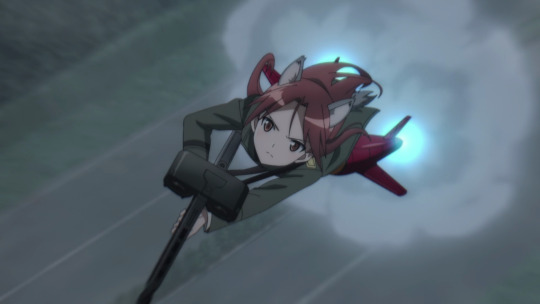
Rising Tension
Okay, with the character work out of the way, let’s look at the episode’s story. Because holy crap, I felt like I was watching a movie! At first, I was a little annoyed by some of the stiff animation (especially for RtB’s standards). I was afraid they were going to half-ass Minna’s episode. But as the episode proceeded and absolutely everything got better and better, I realized I was in for a very special ride.
I’ve always had the opinion that Strike Witches is at its best when it plays its war drama straight, but it’s not as simple as striking the serious tone and having the characters fight for their lives. Strike Witches isn’t a pure action show; the stakes in battle often revolve around the characters overcoming their flaws, struggling to protect the world and those they hold dear. Thus, Strike Witches relies on its lighter moments to develop the cast so that when danger comes to them, your emotional investment in the characters helps to create additional tension.

In general, RtB has been great at this, but for me personally, the most emotionally intense episode prior to Minna’s Sky was Episode 6: Hounds of Vengeance.
But that one was different. It started off with relatively low tension, then brought it up to full when Erica was left behind and Trude had a meltdown over it. But when it’s revealed that Trude isn’t just moping around, and that she’s working on a plan, the tension evens out. The central question goes from ‘Will Erica survive?’ to ‘How awesome will Trude be in this episode?’ The climactic action is triumphant, and although Trude’s reaction to Erica’s ‘body’ is heartbreakingly real, we as viewers know that Erica is fine; in fact, she hasn’t seemed that down at all, obviously having faith in her rescue.

Episode 9 doesn’t do that. It immediately confronts you with Minna’s magic issue and her hiding it from her friends, then pretends to be innocent for a while, with Patton being an idiot and Ursula introducing her helmet gun. (“It’s a helmet, with a gun on it.” NO, REALLY?) But as soon as the Komet is introduced, the pressure builds and it never lets up.
It all comes to a head when the trio (plus Ursula) reaches the launch point. Minna’s been dropping death flags all episode, and now things go haywire over and over. An hour left? Nope, the Neuroi spotted you and moved up the rocket’s launch. Barely enough time to intercept the rocket? Hey, there’s that Neuroi that beat the two top aces of the world in single combat, and it’s coming to stop you. Thirty seconds to go for the fuel? The Neuroi gets past Trude and Erica and nearly destroys the Komet, hurts Ursula and blows up one of their trucks. Trude and Erica get it away from there? Oh look, the Hive’s about to launch!

We then get an epic scene where Minna takes off, uses her magic, and destroys the rocket. Speaking of which, I didn’t say anything about this when I talked about episode 8, but I’m so happy we finally get to see some of the Witches’ magic from their point of view! Seeing Eila’s future sight was haunting, and Minna’s is awesome to see as well. Erica and Trude manage to finish off their quarry, showing their skill and adaptability; it seems their prior experience means they’re better prepared to deal with its unique movements this time around.
Erica asks for chocolate and grumbles when Trude tells her she’ll get some later. Minna laughs, but there’s still that tension because Minna’s fuel is almost up, and she’s hanging around that damn Hive.

And then the Hive loads up all its rockets at once, and all hell breaks loose. Trude loses control of the situation as Minna goes on a suicide run, and then the insert song starts playing. It’s difficult to explain the impact of that song without simply showing you the episode. The moment that piano hits, it feels as though a veneer of tragedy descends upon the scene. The Komet nearly stops working, and Minna is on her last legs, and she’s reduced to nothing but cries and gasps. She faints moments after she destroys the last rocket.
And then the music gets louder as Minna plummets into the Hive, red slowly filling the screen. We’re treated to a long shot of Minna falling into the swirling, angry clouds, her tiny form fading into its mass. And at that point I freaked the fuck out.

It was somewhere around Season 2’s finale and watching the movie that I realized Strike Witches doesn’t kill off characters. Let’s just say killing a beloved character probably wouldn’t work too well for future sales. (“Hey, look at this awesome figure of the girl who died! Don’t you just love her? We’ll accept your tears as interest.”) If Mio of all people can have plot armor rivaling the size of the planet, then Minna sure as hell won’t perish here.
And yet, for a fleeting moment, I was absolutely terrified she would. All because of the masterful tension of this episode, and this entire fight scene in particular.
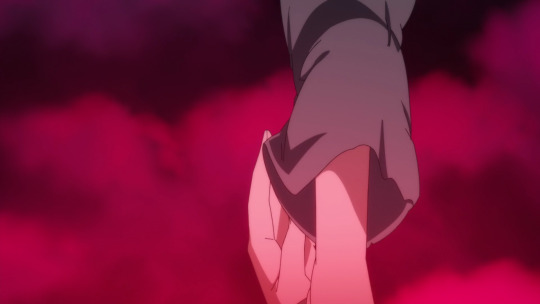
Fortunately, Trude manages to locate Minna in the clouds and brings her back, and the viewer can finally breathe easier as we head to the happy ending they deserve.
…Oh right, the ending.

Yuri alert
Let me start off by saying this ending is complete bullshit. It feels shoehorned in—no, I don’t care what historical event it’s referencing—and it doesn’t fit the tone of the episode at all.
Having said that, as much as this made me laugh (even more than Trude’s literal asspull in Hounds of Vengeance) it did get one thing completely right: yes, Ursula, it IS very beautiful. The love between these three is great. What kind of love that exactly is, I’m not entirely sure anymore.

Yes, you’re going to roll your eyes at this—oh no, she’s going to rant about Minna x Trude again—but…I was watching this ending, right, and I could almost hear the gears in my brain turn as I tried to process this image. Emotionally, I felt like this ending was communicating love of a different sort.
Look, for all I know they’re just best buds who’ve come to deeply rely on one another for emotional and psychological stability, but my god, this ending definitely felt like a ‘oh by the way, the three of them are married to each other’ signal to me. I’m not joking!
Does that make Minna x Trude canon, even as part of an OT3? No. In fact, for all the delightful Minna x Trude subtext this episode had…

Deflection by way of flirtation. Oh là là~!
…Trude did all but confess to Erica in episode 6, and later this week, Mio might finally return in a big way and might have screen time with Minna. But my point is, in that moment, my ship felt realer than ever. In that respect, this episode gave me more than I ever thought I’d receive.
Insert clever ending header here
Right, so that’s my ramble on Minna’s Sky. I hope I’ve managed to get across why I believe it’s the best episode of the entire series. The character writing was top-notch, the tension was through the roof, the music was evocative and the animation was beautiful. Barring an absolutely spectacular final three episodes (and I wouldn’t put it past RtB to deliver that), I think this is as good as it gets. It’s not easy to beat emotional stakes that were established twelve years ago, after all.

Minna’s Sky was absolutely the episode Minna deserved, and I was very happy to see the Karlsland Trio getting its spot in the limelight as we gradually draw closer to the ending. It’s their home they’re trying to take back, after all. And while I have no doubt Minna will continue to fly until the end of the season (she seems to be fine in the preview), Operation Southwind will most likely be the bookend to Minna and Trude’s careers.
I can only hope this won’t be the last we see of Minna and Trude. I’d love it if we got to see their lives after Karlsland’s liberation, either as supporting members of the Wing or trying to live normal lives after fighting a war for nearly a decade. (Shameless plug: I have a Minna x Trude fanfic which explores the latter.)

But most of all, I don’t want Road to Berlin to end.
#strike witches#road to berlin#minna-dietlinde wilcke#gertrud barkhorn#erica hartmann#minna x trude#minna x trude x erica?#anime
9 notes
·
View notes
Photo

Vintage Photos of Berlin Cabaret Artists (1920s-1930s) | FROM THE BYGONE Marlene Dietrich (1901-1992). Her earliest professional stage appearances were as a chorus girl on tour with Guido Thielscher’s Girl-Kabarett vaudeville-style entertainments, and in Rudolf Ne… Source: Vintage Photos of Berlin Cabaret Artists (1920s-1930s) | FROM THE BYGONE
#Actress#Anita Berber#Berlin#Blandine Ebinger#cabaret#dancer#Kate Kühl#Margo lion#Marlene Dietrich#Ruth Harriet Louise#singer#Trude Hesterberg#Valeska Gert#Weimar Berlin
6 notes
·
View notes